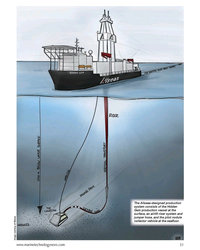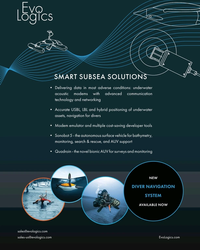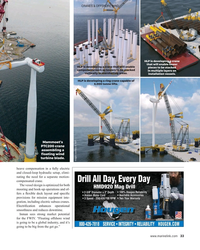Surface Production Equipment
-
- New Offshore Environmental Lubricant Marine Technology, Jan 2014 #22
During the OTC Brazil 2013 in Rio de Janeiro, MTR’s correspondent Claudio Paschoa met with Chris Morrissey, who is Team Leader in Energy Lubricant Development for Castrol in the UK, and Carmen Pino, Regional Sales Director for Castrol Offshore for a chat about the new Environmental Lubricant being developed by Castrol Offshore with the support of OneSubsea. This barrier oil provides extreme thermal stability, good electrical insulation and lubricity, and fully meets the tightest OSPAR environmental legislation
The O&G industry is increasingly targeting deepwater plays, where subsea equipment such as pumps, manifolds and Xmas trees are constantly under high pressure, be it the water pressure at depths that may exceed 2,000m or high pressure from the reservoir itself. There is also the heat coming from the reservoir and the cold from the deep ocean waters which may affect subsea equipment.
Most subsea equipment uses some form of lubricating oil, which is used to lubricate hydrodynamic bearings, mechanical seals and other internal components, but also acts as cooling medium in motor, pump or compressor components. Lubricants additionally keep certain insulation properties in motor and power penetrators, along with transporting wear particles to filters and acting as a barrier between sea/process and internal components. “There were a couple of main drivers in developing the new lubricant. One was the need for environmentally enhanced lubricants, because the traditional kinds lubricants used for subsea applications at the moment do not meet the tighter environmental legislation being introduced, so we wanted to develop a product, which was fully compliant to the stringent environmental legislation in the North Sea. Then, through this development, it became clear that there was a need to extend the performance of the lubricant in order to reach thermal stability requirements. The current conventional lube stars to break down at 100 °C and we managed to extend the thermal stability of the new lube to 220 °C,” said Morrissey. The development of a enhanced lubricating oil is a long process, which involves identifying raw materials, formulation screening and the optimization of additives long before any rig or equipment testing is done. “When we started out we didn’t really know what we could achieve with the environmental lube, so there was a bit of a challenge there. The typical additives used in standard lube oils don’t pass the environmental legislation tests, so we had to search for new chemicals, new additives, new building blocks,” said Morrissey.
The major testing in the development stage involves thermal stability testing, TAN variation testing, fluid drying test with coalescing filter and motor insulation compatibility testing, all of which are done at Castrol’s Technology Center in Pangbourne, near Reading, west of London. “We have development centers all over the world, but for energy and more specifically for subsea, Pangbourne is where it happens,” said Morrissey. “The development work with OneSubsea has been going on for seven years now. We build a collaborative relationship with OneSubsea knowing it would take a bit of time to get through this development, in order to go through all the improvement testing and so on. The key thing in this industry is that everyone wants to know that the product is absolutely going to work and that takes a long time.”
Also according to Morrissey, the finished product should be ready to go to the market by mid 2014 and the launching location is still uncertain.
“The way we run our organization, we may choose a specific region to launch it but in general cases, especially with the level of certainty we have in the product, we can globally launch pretty seamlessly throughout the organization,” said Pino. Since the lubricant was conceived to pass the North Sea environmental legislation, there is a good possibility that it will be first launched in the North Sea, however Morrissey quickly pointed out that “We have to figure out where the first unit using the lube will be delivered and then support it in that region first, as a priority.”
There are certainly important advantages offered by the new product, and with the enormous growth that is occurring in the subsea industry these advantages may become an important deferential for players and equipment manufacturers to embrace Castrol’s environmental lubricant.
“We are quite excited about two key areas where we see that the new lube has great advantage. One is the demand for this kind of lube from locations where field conditions are really hot and the other is use of the lube in subsea boosting and compression equipment, where OneSubsea is getting to the end of development testing in the use of the lube in its subsea wet gas compressor. Up to now testing has indicated that this lube is ideal for the requirements of this technology. Subsea boosting and compression technology is increasingly being used in deepwater fields as it offers increased operational flexibility, while at the same time bringing some of the surface production equipment to the seafloor. This technology has proven to bring advantages, such as increased production, recovery and flow assurance. Yet some of the equipment requires a lubricant oil with high thermal rating in order to increase performance and reliability.
Depending on the location where the equipment will be used, there may also be a requirement to comply with specific environmental legislation.
“Thermal stability is really the key aspect of the product, along with the controlled amount of additives used. When we look at the mechanical seals for example, these run at high speeds, creating a pressure differential, which generates a lot of heat. If the lubricant breaks down at high temperatures you get deposits building up on the face of the seals which may cause long term reliability issues. You don’t want anything flaking out across those surfaces, you want them to remain absolutely clean and in order to attain that you need a lube with a high thermal stability and a perfectly balanced additive count, because additives can drop out of the fluid and cause lacquering of the seal face”, said Morrissey.
Castrol is a global company and as such they have many options on how to market the new product.
“I think there are two elements we need to take into consideration when marketing this product. First there is the equipment and project we know of today, where we will be working collaboratively with the technical departments, receiving direct feedback on the product. There is also a more interesting part, where we try to discover in what other applications the lubricant can be used, for instance, thrusters and well capping may benefit from this kind of lubricant, the potential is huge and that’s where our global organization will come into play,” said Pino.
Facts about the new Environmental Lubricant
• Performance assurance has been achieved by benchmarking the fluid through testing against existing lubricants of known performance and track record,
• An alternative environmental oil solution, which has little or no additional risk to reliability, and with the benefits of higher performance,
• Further rig testing and real life machine running hours will ensure maximum confidence before launch,
• For wet gas compressor the contra-rotating seal tests and full compressor trial are planned, with TRL4 to be reached by March 2014,
• Next steps for the hot pump development (400F/ 204C) is to qualify the elastomers/polymers over a wide temperature range for extended periods,
• Market demand for larger capacity machines will push performance limits of the barrier oil.
(As published in the January/February 2014 edition of Marine Technology Reporter - www.seadiscovery.com)
-
 )
March 2024 - Marine Technology Reporter page: 45
)
March 2024 - Marine Technology Reporter page: 45ronments. The new agreement will address speci? c techni- cal gaps in the UUV defense and offshore energy markets especially for long duration, multi-payload mission opera- tions where communications are often denied or restricted. As part of the new alliance, Metron’s Resilient Mission Autonomy portfolio
-
 )
March 2024 - Marine Technology Reporter page: 44
)
March 2024 - Marine Technology Reporter page: 44. The CL-360 Marine is the only lidar of evaluating and classifying the potential objects of interest. system designed for use on an uncrewed surface vessel (USV) Teledyne Geospatial brought its latest advancements in that provides survey grade range and accuracy. ocean mapping hardware and software
-
 )
March 2024 - Marine Technology Reporter page: 42
)
March 2024 - Marine Technology Reporter page: 42NEW TECH OCEANOLOGY INTERNATIONAL 2024 Image courtesy Greg Trauthwein Image courtesy BIRNS MacArtney launches the new ultra-compact ø12.7 mm SubConn Nano connector. Innovative connectivity built on 45 years of ? eld-proven and market-trusted design. Image courtesy MacArtney Birns celebrated its 70th
-
 )
March 2024 - Marine Technology Reporter page: 40
)
March 2024 - Marine Technology Reporter page: 40, during and after the London event. as AI powered obstacle detection and avoidance capabilities. VEHICLES Exail unveiled its new transoceanic Uncrewed Surface Ves- In addition, the new USV is able to launch and recover a wide sel (USV), the DriX O-16. Bene? tting from an autonomy of range of subsea assets
-
 )
March 2024 - Marine Technology Reporter page: 39
)
March 2024 - Marine Technology Reporter page: 39leads brought out to the CBA V. The CBA V can perform a Power Pro? le, useful for designers working with solar charging systems on buoys and unmanned surface vehicles (USV). For very low currents, continuous or intermittent, the West Mountain Radio CBA HR (High Resolution) model is designed to test any
-
 )
March 2024 - Marine Technology Reporter page: 37
)
March 2024 - Marine Technology Reporter page: 37? uid other than electrolyte into the interior air-? lled voids of the cells. The compensating ? uid will have a dielectric strength, miscibility, and surface tension unlike the electrolyte. It is suspected that the compensating ? uid prefer- entially wicks by capillary action into the glass mat, displac- ing
-
 )
March 2024 - Marine Technology Reporter page: 36
)
March 2024 - Marine Technology Reporter page: 36. Any compensation ? uid must consider be con? gured to be as high as 96KWh, though it was typically speci? c gravity, miscibility, and surface tension with respect between 76KWh and 84KWh on the 12 manned dives. These to the electrolyte. came from a maximum of 96 PBOF LiPo battery packs
-
 )
March 2024 - Marine Technology Reporter page: 34
)
March 2024 - Marine Technology Reporter page: 34instrumentation on ocean landers, acti- generation process is not perfect, and some material is lost vate the release of the descent weight, and power surface in each discharge-recharge cycle. This limits the number of recovery beacons. times the battery may be recharged, known as cycle life. BATTERY
-
 )
March 2024 - Marine Technology Reporter page: 33
)
March 2024 - Marine Technology Reporter page: 33possible gradually. Hundreds of collectors can be de- ployed concurrently. Once a collector has achieved its 6,000kg payload, it can return to the surface, and as the surface vessel reaches capacity, it can return to shore while the collectors continue to load on a second vessel. There is no sediment
-
 )
March 2024 - Marine Technology Reporter page: 31
)
March 2024 - Marine Technology Reporter page: 31The Allseas-designed production system consists of the Hidden Gem production vessel at the surface, an airlift riser system and jumper hose, and the pilot nodule collector vehicle at the sea? oor. Image courtesy of Allseas www.marinetechnologynews.com 31 MTR #3 (18-33).indd 31 4/4/2024 2:12:41
-
 )
March 2024 - Marine Technology Reporter page: 30
)
March 2024 - Marine Technology Reporter page: 30FEATURE SEABED MINING bilical. It has passive heave compensation which nulli? es the necott. “The focus since then has been on scaling while en- wave, current and vessel motions that in? uence loads in the suring the lightest environmental impact,” says The Metals power umbilical. The LARS can
-
 )
March 2024 - Marine Technology Reporter page: 25
)
March 2024 - Marine Technology Reporter page: 25would have both instruments: seismom- Skett, “and the change in salinity and dis- found up to seven km3 of displaced ma- eters to detect and locate subsurface ac- solved particles for comparison studies terial from the sea? oor, according to a tivity, and hydrophones to study activity against samples
-
 )
March 2024 - Marine Technology Reporter page: 20
)
March 2024 - Marine Technology Reporter page: 202024 November/December 2024 December 2024 Ad close Dec. 4 Ad close Sept. 21 Ad close Nov. 21 Ocean Observation: Gliders, Buoys Digital Edition & Sub-Surface Networks MTR100 ??QVWUXPHQWDWLRQ3UR?OHUV6DPSOHUV 6HGLPHQW&RUHU Focus on 100 Leading Companies, ?$'&3V '9/V People and Innovations in the ?6XEVHD'HIHQV
-
 )
March 2024 - Marine Technology Reporter page: 13
)
March 2024 - Marine Technology Reporter page: 13nyone familiar with glider hardware options integrated for a broad Glider answers that need,” said Shea autonomous underwater ve- range of missions. Quinn, Slocum Glider Product Line hicles (AUVs) is certainly “As the use of Slocum Gliders grew, Manager at TWR. A familiar with the popular- so did
-
 )
March 2024 - Marine Technology Reporter page: 9
)
March 2024 - Marine Technology Reporter page: 9coast. The exact number of lizing laser detection systems can detect mines just below the mines, as well as their locations, remains largely a mystery, surface, even those hiding in murky water. The Airborne Laser although reports suggest that over three hundred have been Mine Detection System (ALMDS) from
-
 )
March 2024 - Marine Technology Reporter page: 4
)
March 2024 - Marine Technology Reporter page: 4Editorial NIWA-Nippon Foundation TESMaP/ Rebekah Parsons-King www.marinetechnologynews.com ast month marked the resounding NEW YORK 118 E. 25th St., New York, NY 10010 return of Oceanology Interna- Tel: (212) 477-6700; Fax: (212) 254-6271 tional in London, perennially one Lof the world’s most important
-
 )
March 2024 - Marine Technology Reporter page: 2nd Cover
)
March 2024 - Marine Technology Reporter page: 2nd Coverand hybrid positioning of underwater assets, navigation for divers • Modem emulator and multiple cost-saving developer tools • Sonobot 5 - the autonomous surface vehicle for bathymetry, monitoring, search & rescue, and AUV support • Quadroin - the novel bionic AUV for surveys and monitoring NEW DIVER NAVIGATION SY
-
 )
April 2024 - Maritime Reporter and Engineering News page: 47
)
April 2024 - Maritime Reporter and Engineering News page: 47MARKETPLACE Products & Services www.MaritimeEquipment.com Powering the fleet for 60 years! HYDRAULIC NOISE, SHOCK AND VIBRATION SUPPRESSOR Noise, Shock, VibraO on & PulsaO on in Quiet, Smooth Flow Out Oil Bladder Nitrogen (blue) Manufactured by MER
-
 )
April 2024 - Maritime Reporter and Engineering News page: 43
)
April 2024 - Maritime Reporter and Engineering News page: 43“The industry is an ecosystem which includes owners, managers, mariners, shipyards, equipment makers, designers, research institutes and class societies: all of them are crucial,” – Eero Lehtovaara, Head of Regulatory & Public Affairs, ABB Marine & Ports All images courtesy ABB Marine and Ports provi
-
 )
April 2024 - Maritime Reporter and Engineering News page: 42
)
April 2024 - Maritime Reporter and Engineering News page: 42OPINION: The Final Word Seeing the Ship as a System Shipping must engage with the decarbonization realities that lie ahead by changing the way it crafts maritime legislation to re? ect its place in the interconnected, interdependent world economy, said Eero Lehtovaara, ABB Marine & Ports. ABB Marine &
-
 )
April 2024 - Maritime Reporter and Engineering News page: 35
)
April 2024 - Maritime Reporter and Engineering News page: 35SIMULATION e have a close relationship with tech- Realism is prized beyond immersive, photo-realistic visu- nology, evidenced by, for example, als, and providers are introducing increasingly accurate func- the phones we are estimated to un- tionality. FORCE Technology’s upcoming DEN-Mark2 math- lock around
-
 )
April 2024 - Maritime Reporter and Engineering News page: 33
)
April 2024 - Maritime Reporter and Engineering News page: 33CRANES & OFFSHORE WIND HLP is developing a crane that will enable tower HLP is developing a crane that will enable pieces to be stacked components such as towers to be stacked in multiple layers on vertically in marshalling areas. installation vessels. HLP is developing a ring crane capable of 6
-
 )
April 2024 - Maritime Reporter and Engineering News page: 27
)
April 2024 - Maritime Reporter and Engineering News page: 27an all-tonnage us about your ? eet? license can pretty much sail on any of our ships and can be The Combat Logistics Force will be familiar to our Surface detailed world-wide, although some ships like EPF require Force Sailors. We have 14 Henry J. Kaiser-class ? eet replen- high-speed craft (HSC)
-
 )
April 2024 - Maritime Reporter and Engineering News page: 25
)
April 2024 - Maritime Reporter and Engineering News page: 25RADM PHILIP SOBECK, MILITARY SEALIFT COMMAND Photo by Brian Suriani USN Military Sealift Command From a global supply chain perspective, What makes MSC so vital to the we’ve learned a lot about dealing with Navy’s ? eet and our military disruptions. COVID delivered a big forces around the world? wake-up
